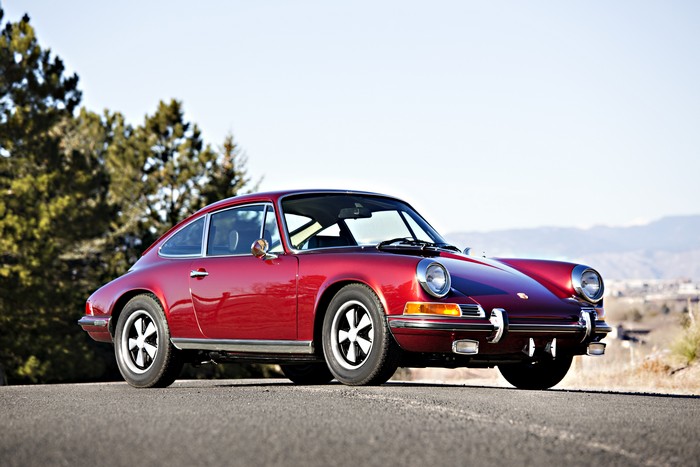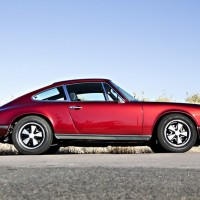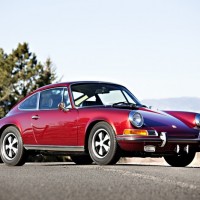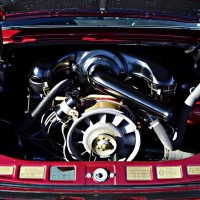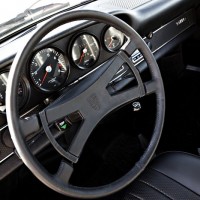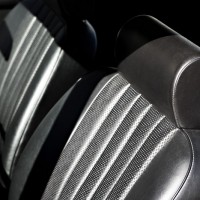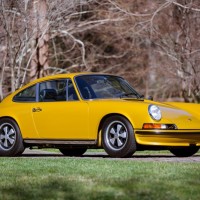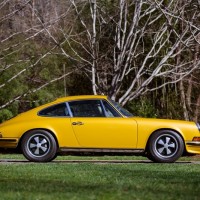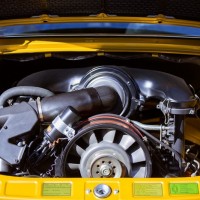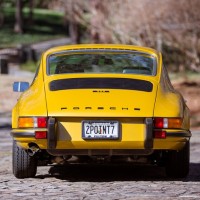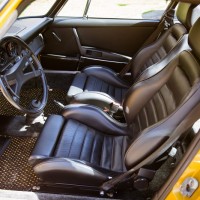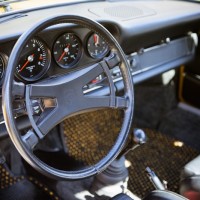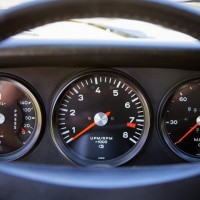Every auction has surprising results, but the sales of these two Porsche 911S cars — on the same day, in the same tent and before many of the same bidders — provide some insight into the current state of Porsche 911S values. Let’s first take a close look at both cars.
SCM Analysis
Detailing
| Vehicle: | 1969 Porsche 911 |
| Years Produced: | 1969 and 1973 |
| Number Produced: | 1,492 for 1969 and 1,470 for 1973 |
| Original List Price: | $7,695 and $10,160 |
| Tune Up Cost: | $800 with valve adjustment for either car |
| Chassis Number Location: | Riveted alloy plate in front of trunk; stamped into bodywork above spare tire (for both cars) |
| Club Info: | Porsche Club of America |
| Website: | http://www.pca.org |
1969 Porsche 911S 2.0
This 911S, Lot 15, sold for $143,000, including buyer’s premium, at Gooding & Company’s Amelia Island, FL, auction on March 8, 2013.
Some well-known shops and mechanics in Colorado had just recently completed a full restoration on this car. Gooding’s catalog made one point early — and then again: “(This car) benefits from the attentions of one of the nation’s leading Porsche authorities, a 30-year veteran of Porsche Club events who has devoted approximately 800 hours of his time to the quality control and authenticity of this car.’’ Gooding was referring to a well-known Denver-area Porsche aficionado who has earned the praise bestowed on him. While that expert undoubtedly added many concours points and a lot of value to this 911S, he may have taken on a project that was flawed to begin with.
First, good points about the 1969 S included numbers-matching engine and gearbox, matching colors, correct trim, and a full and correct tool kit — all backed up by a Certificate of Authenticity presented with the car. The car also had a lot of eyeball, principally because of the special-order Metallic Dark Red paint. The “deep-six” Fuchs wheels stood tall, and the interior was well executed. There were few doubts about the mechanical integrity of this car, as all of it was the work of well-known, capable technicians.
On the minus side, this 911S was moderately optioned, with no sunroof, no sport seats, and no air conditioning. Any of those options add meaningful value to a Porsche 911. Put them all together, and there is a big uptick. Also, the otherwise-impressive paint had a small area on the hood starting to show shrinkage.
One could say that the $143,000, after buyer’s premium, was fair — if not full money. Yet the consignor, who offered the car without reserve against a pre-sale estimate of $130,000–$160,000, told me that he was quite disappointed at the result. What happened?
The car had some negative buzz trailing along behind it. It had been pieced together with a front clip and lots of other fresh sheet metal — not all of it precisely correct for the car — although none of it would affect appearance or usability. The shop that did the welding work even documented it with a printed brochure. Thus, the extensive metalwork was hardly a secret. Perhaps more concerning was the quiet story circulating that the front clip was ever so slightly off-kilter, squeezing the gaps on the passenger’s side and widening those on the driver’s side — despite a lot of handwork to compensate for the flaws.
It is entirely possible that the potential buyers who bid this no-reserve car up had no detailed knowledge of the bodywork. Not so the cognoscenti in the tent who otherwise might well have bid on this attractive car— in an unusual color — with good provenance. That their paddles did not wave had to hold down the price realized.
1973 Porsche 911S 2.4
This 911S, Lot 67, sold for $198,000, including buyer’s premium, at Gooding & Company’s auction at the Omni Amelia Island Plantation in Florida on March 8, 2013. Unlike the freshly restored Metallic Dark Red 1969 911S that crossed the block earlier in the day, this car was an older restoration that had been well preserved — but was off its best presentation.
The car did have a lot going for it. The Gold Metallic paint is a striking color that is not frequently seen. The meaningful original options were leather interior and tinted glass — plus uprated sway bars and Koni shocks.
However, the car had a couple of serious deviations from delivery specs.
Later and larger aftermarket sports seats were fitted, and they looked very much out of place. The engine had been built up to 2.7-liter specs, with larger pistons and cylinders on what appeared to be a stock 2.4 case. Finally, the headliner was either a rare optional (but not on the Certificate of Authenticity) black one or it was replaced at restoration, presumably to emulate the standard headliner on the lightweight M471 Carrera RS.
While none of those changes were deal killers, they were disappointing. The car then hammered sold for a strong $198,000 after adding in the 10% buyer’s premium.
I am on the record as saying that a 1969 911S is more valuable than a 1973 911S, car for car. So, why did the 1973 911 make more than the 1969 car? What happened in the Gooding tent?
1969 versus 1973
Let us, for the moment, set aside any meaningful differences in current condition, restoration quality and presentation. So, what intrinsic qualities of the two cars could have contributed to the different auction results seen at Gooding Amelia Island?
The similarities in the 1969 and 1973 cars are much more substantial than the differences. Both are long-wheelbase cars; the increase from 87.0 inches to 89.4 inches first appeared with the 1969 models.
Both cars also are from the mechanical fuel-injection era — known as MFI to aficionados — that started in 1969 and ended in 1973. That important change allowed more powerful Porsche engines to clear tightening emissions requirements.
That same 1969-to-1973 time span also encompassed the three-model continuum of 911T to 911E to 911S, with differences between the models sometimes more important than the year-to-year changes within a model designation. The available options were also not terribly dissimilar.
Small differences to bigger preferences
All that said, collectors use small differences between cars to create their preferences. If enough buyers head in that direction, big valuation differentials can result.
Between our two auction cars, the change with the biggest impact was engine displacement. The 1969 model continued the 1,991-cc engine, with which the 901/911 was born in the fall of 1963. The 1970 and 1971 models moved to 2,195-cc engines and are called 2.2-liter cars. Then came the 2,341-cc engine, aka 2.4s, of 1972–73. There were resultant performance variations, of course, but not as precisely linear as one might expect.
Some attributes of the 2.4-liter 1972-73 cars are favored. They have the updated Type 915 gearbox — which is stronger and has first gear in the H pattern and fifth outside. In contrast, the previous Type 901 box had first outside the H, requiring a move through a gate for each startup after a stop.
Among the low-bumper, aka long-hood, 911s, the 2.4-liter has the largest engine, and it has the highest horsepower rating. It is also the last model of the low-bumper 911s before the government-mandated 1974 changeover to impact-resistant bumpers.
Some collectors prefer the smaller-displacement cars. They are lighter, more raw — or slightly less civilized — and feature the high-pitched, wailing exhaust note. Those fans think the 1972–73 2.4 cars are more boulevard — and less performance.
Road & Track performance data and factory specifications
When you cross-check performance numbers, you get insights into the differences between these seemingly similar cars. Please consider this performance data taken from Road and Track’s road-test results, cross-referenced with factory-supplied tech data, for the 2.0-liter to 2.2-liter to 2.4-liter 911Ss:
| 2-liter | 2.2-liter | 2.4-liter | |
| Horsepower | 170 | 180 | 190 |
| Torque | 134 ft-lbs | 147 ft-lbs | 158 ft-lbs |
| Compression ratio | 9.9:1 | 9.8:1 | 8.5:1 |
| 0–60 mph time | 8.1 seconds | 7.3 seconds | 7.8 seconds |
| Quarter-mile times | 15.7sec/88.1 | 14.9sec/88.5 | 16.3sec/93.5 |
| Top speed | 141 mph | 144 mph | 142 mph |
| Base weight | 2,248 lbs | 2,314 lbs | 2,369 lbs |
| Base MSRP | $7,695 | $8,750 | $10,160 |
The standing-start quarter-mile results are perhaps the most intriguing numbers. The 2.2-liter gets to the line first because it has higher speed early. The 2.4 clears the traps at the higher speed, but its weight slows it down off the line. And check those compression ratios. The above data might lead you to join the small-but-vocal band that believes that the 2.2S is the best early 911. Its performance numbers, power-to-weight, and yes, its high-pitched howling exhaust note, win over these enthusiasts.
One also could ask about the effect of availability, but there is little difference here. Porsche built 1,492 911S coupes in 1969 and 1,430 911S coupes in 1973. While total production grew by 50% between 1969 and 1973, it was all in the lower models, the E and the T.
A surprised Porsche writer
As a very interested Porsche writer and small-time collector, I believed that the 2.0-liter and 2.2-liter 911S should be more valuable than the later 2.4-liter model. On March 8, 2013, in Amelia Island, FL, that reading was very wrong.
Were the differences between the two cars the cause of the value flop? There were some subtle — but possibly important — differences in the metalwork on the two cars.
The metalwork history on the 1969 911S was known to at least a few. The 1973 was more of an enigma — no one in the auction tent seemed to have stories about it.
Were the different price results simply the vagaries of the bidders present? That’s an element in any auction, of course, and it was impossible to assess. Or were the day’s results reflective of a move toward the 2.4s as a favored model among early 911s? That possibility will need to be reassessed as more auction and market results come in. ?
